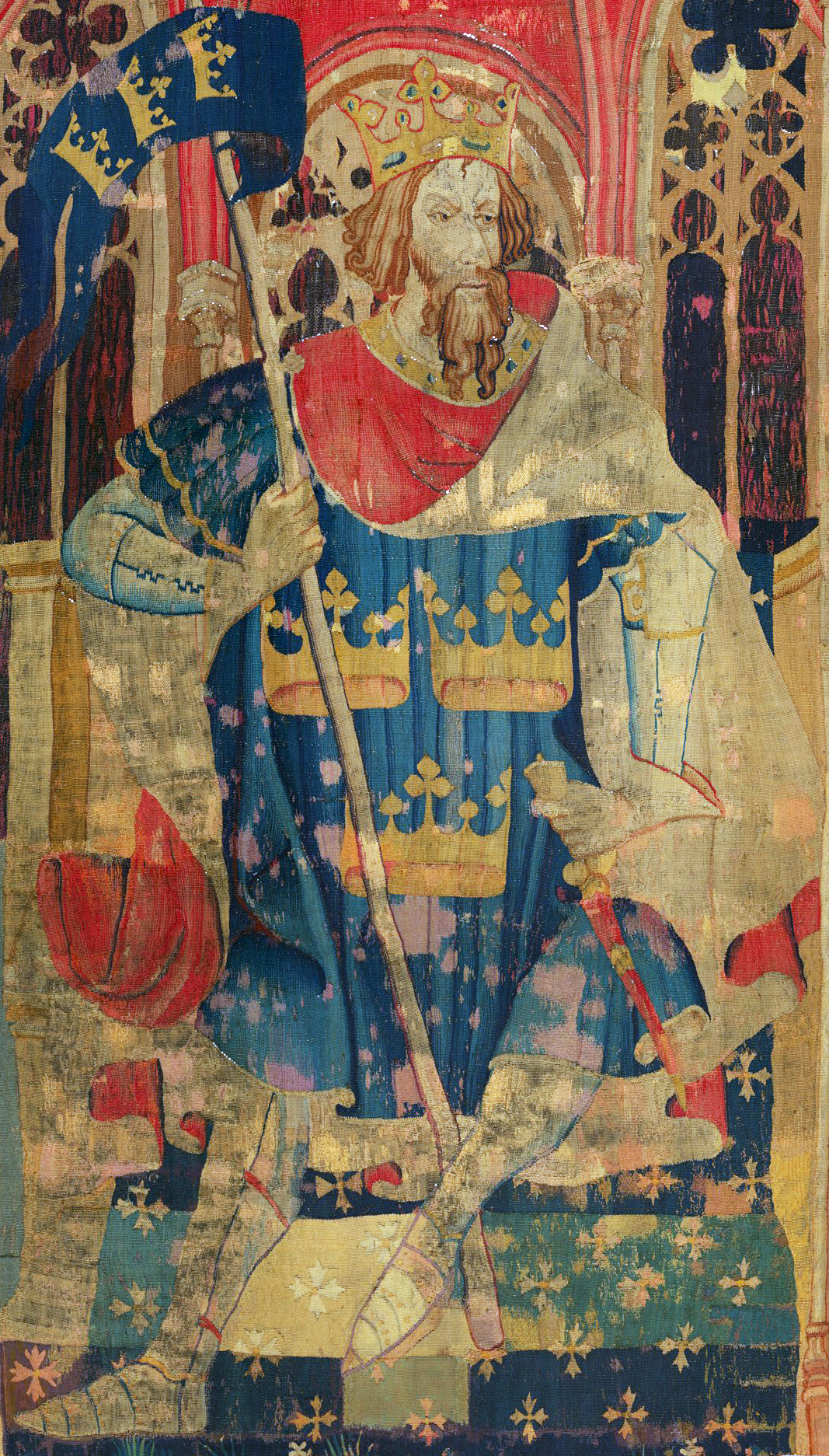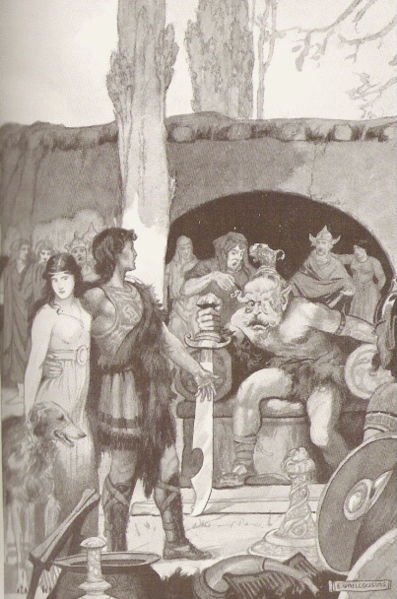|
Gwyn Ap Nudd
Gwyn ap Nudd (, sometimes found with the antiquated spelling Gwynn ap Nudd) is a Welsh mythological figure, the king of the '' Tylwyth Teg'' or " fair folk" and ruler of the Welsh Otherworld, Annwn, and whose name means “Gwyn, son of Nudd”. Described later on as a great warrior with a "blackened face", Gwyn is intimately associated with the otherworld in medieval Welsh literature, and is associated with the international tradition of the Wild Hunt. Family Gwyn is the son of Nudd and would thus be grandson to Beli Mawr and nephew of Arianrhod, Llefelys, Penarddun, Afallach, Gofannon, Nynniaw, Peibaw, and Caswallawn. Based on their shared patronymic (''ap Nudd''), his siblings include Edern, a warrior who appears in a number of Arthurian texts, and Owain ap Nudd, who is mentioned briefly in Geraint and Enid. In '' Culhwch and Olwen'', Gwyn is the lover of Creiddylad, the daughter of Lludd, who may therefore be Gwyn's own sister, though that connection was not made by ... [...More Info...] [...Related Items...] OR: [Wikipedia] [Google] [Baidu] |
Annwn
Annwn, Annwfn, or Annwfyn (; ''Annwvn'', ''Annwyn'', ''Annwyfn'', ''Annwvyn'', or ''Annwfyn'') is the Otherworld in Welsh mythology. Ruled by Arawn (or, in Arthurian literature, by Gwyn ap Nudd), it is a world of delights and eternal youth where disease is absent and food is ever-abundant. Name and etymology Middle Welsh sources suggest that the term was recognised as meaning "very deep" in medieval times. The appearance of a form ''antumnos'' on an ancient Gaulish curse tablet, which means ''an'' ('other') + ''tumnos'' ('world'), however, suggests that the original term may have been *''ande-dubnos'', a common Gallo-Brittonic word that literally meant "underworld". The pronunciation of Modern Welsh ''Annwn'' is . Whereabouts of Annwn In both Welsh and Irish mythologies, the Otherworld was believed to be located either on an island or underneath the earth. In the First Branch of the '' Mabinogi'', it is implied that Annwn is a land within Dyfed, while the context of the ... [...More Info...] [...Related Items...] OR: [Wikipedia] [Google] [Baidu] |
Medieval Welsh Literature
Medieval Welsh literature is the literature written in the Welsh language during the Middle Ages. This includes material starting from the 5th century AD, when Welsh was in the process of becoming distinct from Common Brittonic, and continuing to the works of the 16th century. The Welsh language became distinct from other dialects of Old British sometime between AD 400 and 700; the earliest surviving literature in Welsh is poetry dating from this period. The poetic tradition represented in the work of ''Y Cynfeirdd'' ("The Early Poets"), as they are known, then survives for over a thousand years to the work of the ''Poets of the Nobility'' in the 16th century. The core tradition was praise poetry; and the poet Taliesin was regarded as the first in the line. The other aspect of the tradition was the professionalism of the poets and their reliance on patronage from kings, princes and nobles for their living, similar to the way Irish bards and Norse skalds were patronized for th ... [...More Info...] [...Related Items...] OR: [Wikipedia] [Google] [Baidu] |
Arthurian
According to legends, King Arthur (; ; ; ) was a king of Britain. He is a folk hero and a central figure in the medieval literary tradition known as the Matter of Britain. In Welsh sources, Arthur is portrayed as a leader of the post-Roman Britons in battles against the Anglo-Saxons in the late-5th and early-6th centuries. He first appears in two early medieval historical sources, the '' Annales Cambriae'' and the ''Historia Brittonum'', but these date to 300 years after he is supposed to have lived, and most historians who study the period do not consider him a historical figure.Tom Shippey, "So Much Smoke", ''review'' of , ''London Review of Books'', 40:24:23 (20 December 2018) His name also occurs in early Welsh poetic sources, such as '' Y Gododdin''. The character developed through Welsh mythology, appearing either as a great warrior defending Britain from human and supernatural enemies or as a magical figure of folklore, and was sometimes associated with the Welsh ... [...More Info...] [...Related Items...] OR: [Wikipedia] [Google] [Baidu] |
Culhwch And Olwen
''Culhwch and Olwen'' () is a Welsh tale that survives in only two manuscripts about a hero connected with Arthur and his warriors: a complete version in the Red Book of Hergest, , and a fragmented version in the White Book of Rhydderch, . It is the longest of the surviving Welsh prose tales. Lady Charlotte Guest included this tale among those she collected under the title ''The Mabinogion''. Synopsis Culhwch's father, King Cilydd son of Celyddon, loses his wife Goleuddydd after a difficult childbirth. When he remarries, the young Culhwch rejects his stepmother's attempt to pair him with his new stepsister. Offended, the new queen puts a curse on him so that he can marry no one besides the beautiful Olwen, daughter of the giant Ysbaddaden Pencawr. Though he has never seen her, Culhwch becomes infatuated with her, but his father warns him that he will never find her without the aid of his famous cousin Arthur. The young man immediately sets off to seek his kinsman. He find ... [...More Info...] [...Related Items...] OR: [Wikipedia] [Google] [Baidu] |
Geraint And Enid
Geraint ( ) is a character from Welsh folklore and Arthurian legend, a valiant warrior possibly related to the historical Geraint, an early 8th-century king of Dumnonia. It is also the name of a 6th-century Dumnonian saint king from Briton hagiographies, who may have lived during or shortly prior to the reign of the historical Arthur. The name Geraint is a Welsh form of the Latin Gerontius, meaning "old man". Early sources A "Geraint of the South" appears at the Battle of Catraeth (circa 600) in the poem ''Y Gododdin'', attributed to Aneirin. This is conceivably a reference to Geraint mab Erbin, son of the 5th-century king Erbin of Dumnonia. Geraint is also mentioned as one of the "Three Seafarers of the Isle of Britain" in the Welsh Triads. Geraint's deeds at the Battle of Llongborth are celebrated in the poem "Geraint son of Erbin", which was written probably in the 10th or 11th century and traditionally attributed to Llywarch Hen. However, Derek Bryce, following other ... [...More Info...] [...Related Items...] OR: [Wikipedia] [Google] [Baidu] |
Caswallawn
Cassivellaunus was a historical British military leader who led the defence against Julius Caesar's second expedition to Britain in 54 BC. He led an alliance of tribes against Roman forces, but eventually surrendered after his location was revealed to Julius Caesar by defeated Britons. Cassivellaunus made an impact on the British consciousness. He appears in British legend as Cassibelanus, one of Geoffrey of Monmouth's kings of the Britons, and in the ''Mabinogi'', ''Brut y Brenhinedd'' and the Welsh Triads as Caswallawn, son of Beli Mawr. Name The Common Brittonic personal name ''Cassiuellaunos'' stems from the word ''uellaunos'' ('chief, commandant'). The meaning of the prefix ''cassi-'' has been debated, but it possibly signifies 'tin, bronze'. Cassivellaunus may thus been translated as 'Chief-of-Tin', that is to say 'the inflexible'. The personal name ''Ver-cassivellaunus'' ('True-Chief-of-Tin') is related. History Cassivellaunus appears in Julius Caesar's ''Commentar ... [...More Info...] [...Related Items...] OR: [Wikipedia] [Google] [Baidu] |
Gofannon
Gofannon () is a Middle Welsh reflex of Gobannus, one of the List of Celtic deities, deities worshipped by the Celts, ancient Celts. He features in Welsh mythology, Middle Welsh literature as a great Smith (metalwork), metal worker and as the son of Dôn. His name can be compared with the Old Irish ''gobae'' (gen. ''gobann'') ‘blacksmith, smith’, Middle Welsh / Cornish language, Cornish / Breton language, Breton ''gof'' (pl. ''gofein'') ‘blacksmith, smith’, Gaulish language, Gaulish ''gobedbi'' ‘with the blacksmith, smiths’, all of which are cognate with Lithuanian language, Lithuanian ''gabija'' ‘sacred home fire’, ''gabus'' ‘gifted, clever’. His apparent counterpart in Irish mythology, Goibniu, in addition to his metallurgy, duties as a smith, also takes on the role of a divine hero who brewed an ale of immortality, in addition to being an architect and builder. In Welsh mythology, Gofannon killed his nephew, Dylan Ail Don, not knowing who he was. One of the t ... [...More Info...] [...Related Items...] OR: [Wikipedia] [Google] [Baidu] |
Afallach
Afallach (Old Welsh Aballac) is a man's name found in several medieval Welsh genealogies, where he is made the son of Beli Mawr. According to a medieval Welsh triad, Afallach was the father of the goddess Modron. The Welsh redactions of Geoffrey of Monmouth's ''Historia Regum Britanniae'', Brut y Brenhinedd, associate him with Ynys Afallach, which is substituted as the Welsh name for Geoffrey's ''Insula Avalonsis'' (Island of Avalon), but this is fanciful medieval etymology and it is more likely his name derives from the Welsh word ''afall'' "apple tree" (modern Welsh ''afal'' "apple", afallen "apple tree"Bernhard Maier, ''Dictionary of Celtic Religion and Culture'' (trans. Cyril Edwards, The Boydell Press, 1997). cf. Proto-Celtic *''aballo-'' "apple"< ... [...More Info...] [...Related Items...] OR: [Wikipedia] [Google] [Baidu] |
Penarddun
Penarddun is a figure in Welsh mythology, the wife of Llŷr. The Second Branch of the ''Mabinogi'' names Bran, Branwen, and Manawydan as her children by Llŷr, and ascribes to her two additional sons by Euroswydd: Nisien, a good man, and Efnysien, a conniving troublemaker. The Welsh Triads call Llŷr one of the Three Exalted Prisoners of Britain for his captivity at Euroswydd's hands; this likely refers to a lost tradition of the birth of Penarddun's younger sons. The ''Mabinogi'' names Penarddun as a daughter of the ancestor Beli Mawr was an ancestor figure in Middle Welsh literature and genealogies. He is the father of Cassivellaunus, Arianrhod, Lludd Llaw Eraint, Llefelys, and Afallach. In certain medieval genealogies, he is listed as the son or husband of Anna, cousi ..., but the genealogy is confused; it is possible she was meant to be his sister rather than daughter. The name Penarddun can be translated as "Chief Beauty" or "Most Fair" ( Welsh ''pen'' "head, chi ... [...More Info...] [...Related Items...] OR: [Wikipedia] [Google] [Baidu] |
Llefelys
Llefelys (Middle Welsh orthography ''Llevelys'', ''Lleuelys'', ''Llefelis'') is a character in Welsh mythology appearing in the medieval Welsh tale '' Cyfranc Lludd a Llefelys''. In the tale, Llefelys is king of Gaul while his brother Lludd is king of Britain. The tale appears in the Red Book of Hergest and the White Book of Rhydderch, the source texts for the ''Mabinogion'', and embedded into various versions of the ''Brut y Brenhinedd'', the Welsh adaptation of Geoffrey of Monmouth's ''Historia Regum Britanniae''. Etymology The name Llefelys seems to have been derived from Cligueillus (also spelled Digueillus and Eligueillus in various manuscripts), a character found in Geoffrey of Monmouth's famous pseudo-history ''Historia Regum Britanniae'', which was early on translated into Welsh as the ''Brut y Brenhinedd''. Geoffrey makes Cligueillus/Digueillus/Eligueillus the father of Heli and grandfather of Lud, (the prototype of Lludd), Cassibellaunus, and Nennius. In the Welsh ''Br ... [...More Info...] [...Related Items...] OR: [Wikipedia] [Google] [Baidu] |




